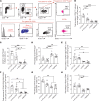Tumor-conditional anti-CTLA4 uncouples antitumor efficacy from immunotherapy-related toxicity
- PMID: 30530991
- PMCID: PMC6307943
- DOI: 10.1172/JCI123391
Tumor-conditional anti-CTLA4 uncouples antitumor efficacy from immunotherapy-related toxicity
Abstract
While immune checkpoint blockade leads to potent antitumor efficacy, it also leads to immune-related adverse events in cancer patients. These toxicities stem from systemic immune activation resulting in inflammation of multiple organs, including the gastrointestinal tract, lung, and endocrine organs. We developed a dual variable domain immunoglobulin of anti-CTLA4 antibody (anti-CTLA4 DVD, where CTLA4 is defined as cytotoxic T lymphocyte-associated antigen-4) possessing an outer tumor-specific antigen-binding site engineered to shield the inner anti-CTLA4-binding domain. Upon reaching the tumor, the outer domain was cleaved by membrane type-serine protease 1 (MT-SP1) present in the tumor microenvironment, leading to enhanced localization of CTLA4 blockade. Anti-CTLA4 DVD markedly reduced multiorgan immune toxicity by preserving tissue-resident Tregs in Rag 1-/- mice that received naive donor CD4+ T cells from WT C57BL/6j mice. Moreover, anti-CTLA4 DVD induced potent antitumor effects by decreasing tumor-infiltrating Tregs and increasing the infiltration of antigen-specific CD8+ T lymphocytes in TRAMP-C2-bearing C57BL/6j mice. Treg depletion was mediated through the antibody-dependent cellular cytotoxicity (ADCC) mechanism, as anti-CTLA4 without the FcγR-binding portion (anti-CTLA4 DANA) spared Tregs, preventing treatment-induced toxicities. In summary, our results demonstrate an approach to anti-CTLA4 blockade that depletes tumor-infiltrating, but not tissue-resident, Tregs, preserving antitumor effects while minimizing toxicity. Thus, our tumor-conditional anti-CTLA4 DVD provides an avenue for uncoupling antitumor efficacy from immunotherapy-induced toxicities.
Keywords: Cancer immunotherapy; Immunology; Oncology.
Conflict of interest statement
Figures








Comment in
-
An adapted anti-CTLA4 therapeutic aimed at mitigating the toxicities of checkpoint inhibition.J Clin Invest. 2019 Jan 2;129(1):75-77. doi: 10.1172/JCI125800. Epub 2018 Dec 10. J Clin Invest. 2019. PMID: 30530990 Free PMC article.
References
Publication types
MeSH terms
Substances
Grants and funding
LinkOut - more resources
Full Text Sources
Other Literature Sources
Molecular Biology Databases
Research Materials
Miscellaneous

